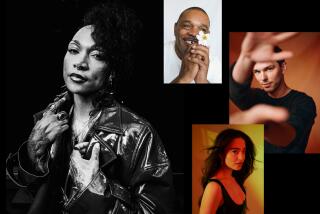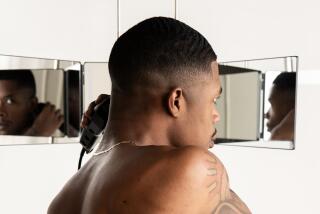They Shoot Celebrities, Don’t They?
- Share via
Ah, the glamorous life of a celebrity photographer.
Warren Beatty pleading with you not to shoot a picture of him with his daughter after you spot the two of them leaving a restaurant on Valentine’s Day.
Putting up with flatulence from a soap opera actress after being invited to take some pictures of her on the set of her show.
Taking a photo of a has-been television star just to make him feel good and, more to the point, to please his publicist, who has a hot star as a client whose picture you want to snap.
Then you have to coax Brad and Gwyneth--oops, they’re split up now, aren’t they?--Brad and whomever he shows up with at the next gala into posing for at least 10 seconds so you can be sure you get a few decent shots to sell. All the while you jostle for position with a crowd of other photographers in the “photo line.”
Worst of all, people use that god-awful word to describe you: paparazzi. The same word you use to describe those shadowy telephoto and video stalkers who have run-ins with guys like Alec, Sean, Arnold and Frank (when he was out on the town more). The guys and gals who would climb any tree, scale any fence or use any disguise for a single shot of Madonna’s baby.
For Kathy Hutchins, it’s all in a day’s--more often late night’s--work. Waiting outside of restaurants for hours to get a shot of a celebrity leaving isn’t her life, at least not anymore.
Her life is snapping hundreds of frames a night of celebrities as they rush into premieres, charity benefits or awards shows. When that’s done, it’s hustling back to develop the shots so they can be FedExed the next morning to photo editors at People, Soap Opera Digest, National Enquirer or the scores of other publications that will decide if she has the freshest shots of the freshest stars to help satisfy America’s unquenchable thirst for celebrity.
“A celebrity photographer is a person invited to cover a press event who is there for the purpose of taking pictures of celebrities and servicing them to magazines and newspapers worldwide,” Hutchins says. “You have something hanging from around your neck that says you have the right to be there.”
Paparazzi, she explains, try to catch celebrities doing something newsworthy, like appearing with a new date, a lover or a mistress. Paparazzi will attempt to take pictures covertly or, if that doesn’t work, nearly attack the celebrities to get a shot.
All this for an average of $125 a photo. But persistence leads to volume, and not a bad living if you can crank it out. Maybe a six-figure income and more celebrities in an hour than your relatives back home have seen in a lifetime. (Hutchins doesn’t like to talk prices for fear it might encourage more people to enter the business).
How do you get into it? Don’t ask working photographers. They won’t offer advice. What’s more, they’ll haze you mercilessly if you try to break in, criticize your work, say your photos are out of focus, do whatever it takes to psych you out. If they do give you any advice or tips, they probably are intentionally misleading. Nobody wants to share those precious inches on the magazine pages with newcomers.
“As a group, we’re pretty closemouthed,” Hutchins says. “We don’t want to encourage anyone to start because there’s only so many positions and only so much space available. The established photographers give you a hard time almost ritualistically. They don’t give you information, they call you names and they attack you personally. They thought it was open season on me. Their entire reason for doing it is to drum as many people as possible out of the business.”
Hutchins herself first came into contact with paparazzi--sorry, celebrity photographers--as an avid autograph collector, a hobby she started as a young girl in Massachusetts, when she gathered the signatures of Boston Red Sox players.
As an adult working as a health-care accountant, she continued collecting autographs, going to shopping malls on days off to wait in line for hours for a scribble from soap opera stars on promotional road shows. After moving to Los Angeles to be closer to family members, she spent evenings after work collecting autographs at places like Spago while noticing that the same group of photographers always camped outside.
It was her curiosity about the photographers that led her to take a stab at trying to become a celebrity shutterbug some nine years ago. She eventually quit her day job, and in the last few weeks formed her own Burbank-based agency with 6,000 celebrity photos on file.
Soap operas were her specialty in the beginning because she’d watched them and recognized the stars. Slowly, Hutchins learned the tricks. When working outside a restaurant like the old Chasen’s, the best time to be there was between 6:30 and 8:30 p.m. One could catch the stars going in, and get the early eaters as they were leaving.
She also learned some of the things editors want, and what is most easy to sell. A Jerry Seinfeld or Jim Carrey or Tom Cruise alone in a tux doesn’t sell. But couples do, especially if the date or wife is a celebrity herself. In addition, shots of female stars have additional marketing potential because they can be sold to fashion pages.
Position yourself next to a photographer with a big mouth who will yell “Hey, Sly!” loud enough for all to hear. That gives you a chance to position, pose and shoot the star in the few seconds it takes the celebrity to respond. Also, dish out the compliments. Sound sincere, even if you don’t like the dress. Keep in mind that celebrities can usually tell if your compliment is insincere.
Then there’s learning the unwritten rules. Celebrities and publicists who cooperate earn goodwill they can bank away to redeem at a later date.
“How you behave yourself determines how much slack we give you the day you’re drunk and don’t want to be shot,” Hutchins says. “If you accommodate us during a press line, and a couple of weeks later you’re having a bad night, you know what? We’ll cut you some slack.”
Finally, shoot everything, because you never know when you’ll need it. Back in March 1994, Hutchins says she and fellow photographers were less than enthusiastic when one of the co-stars at the premiere of “Naked Gun 33 1/3” posed with his family. It turned out to be O.J. Simpson’s last formal public appearance for celebrity photographers with ex-wife Nicole Brown Simpson before she was slain three months later, and the photos became valuable.
“There was a guy next to me who said, ‘Oh, I don’t want this. We don’t need this. My people don’t want it,’ ” Hutchins says. “That person kicked himself for a long time.”


